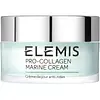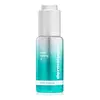What's inside
What's inside
 Key Ingredients
Key Ingredients

 Benefits
Benefits

 Concerns
Concerns

 Ingredients Side-by-side
Ingredients Side-by-side

Water
Skin ConditioningGlycerin
HumectantCaprylic/Capric Triglyceride
MaskingGlyceryl Stearate Se
EmulsifyingIsononyl Isononanoate
EmollientDicaprylyl Carbonate
EmollientDimethicone
EmollientTriticum Vulgare Germ Oil
EmollientButyrospermum Parkii Butter
Skin ConditioningChlorella Vulgaris Extract
Skin ConditioningPadina Pavonica Thallus Extract
Skin ConditioningDaucus Carota Sativa Root Extract
Skin ConditioningPorphyridium Cruentum Extract
Skin ConditioningAcacia Decurrens Flower Extract
MaskingRosa Centifolia Flower Extract
AstringentGinkgo Biloba Leaf Extract
Skin ConditioningTocopherol
AntioxidantPhenoxyethanol
PreservativePolyacrylate-13
Stearic Acid
CleansingTocopheryl Acetate
AntioxidantCoco-Caprylate/Caprate
EmollientCetyl Alcohol
EmollientXanthan Gum
EmulsifyingGlyceryl Polyacrylate
Polyisobutene
Parfum
MaskingCitric Acid
BufferingChlorphenesin
AntimicrobialGlyceryl Acrylate/Acrylic Acid Copolymer
HumectantSodium Dehydroacetate
PreservativeDisodium EDTA
Polysorbate 20
EmulsifyingSorbitan Isostearate
EmulsifyingHydroxyisohexyl 3-Cyclohexene Carboxaldehyde
MaskingButylphenyl Methylpropional
PerfumingLinalool
PerfumingCitronellol
PerfumingPotassium Sorbate
PreservativeSodium Benzoate
MaskingCitrus Limon Peel Oil
MaskingCuminum Cyminum Seed Oil
MaskingCedrus Atlantica Bark Oil
MaskingLimonene
PerfumingWater, Glycerin, Caprylic/Capric Triglyceride, Glyceryl Stearate Se, Isononyl Isononanoate, Dicaprylyl Carbonate, Dimethicone, Triticum Vulgare Germ Oil, Butyrospermum Parkii Butter, Chlorella Vulgaris Extract, Padina Pavonica Thallus Extract, Daucus Carota Sativa Root Extract, Porphyridium Cruentum Extract, Acacia Decurrens Flower Extract, Rosa Centifolia Flower Extract, Ginkgo Biloba Leaf Extract, Tocopherol, Phenoxyethanol, Polyacrylate-13, Stearic Acid, Tocopheryl Acetate, Coco-Caprylate/Caprate, Cetyl Alcohol, Xanthan Gum, Glyceryl Polyacrylate, Polyisobutene, Parfum, Citric Acid, Chlorphenesin, Glyceryl Acrylate/Acrylic Acid Copolymer, Sodium Dehydroacetate, Disodium EDTA, Polysorbate 20, Sorbitan Isostearate, Hydroxyisohexyl 3-Cyclohexene Carboxaldehyde, Butylphenyl Methylpropional, Linalool, Citronellol, Potassium Sorbate, Sodium Benzoate, Citrus Limon Peel Oil, Cuminum Cyminum Seed Oil, Cedrus Atlantica Bark Oil, Limonene
Coconut Alkanes
EmollientPPG-15 Stearyl Ether
EmollientRosa Canina Fruit Oil
EmollientSimmondsia Chinensis Seed Oil
EmollientC13-15 Alkane
SolventCoco-Caprylate/Caprate
EmollientArgania Spinosa Kernel Oil
EmollientSalicylic Acid
MaskingCaprylic/Capric Triglyceride
MaskingIsopropyl Lauroyl Sarcosinate
Skin ConditioningRetinyl Propionate
Skin ConditioningButyl Avocadate
Skin ConditioningPhenylethyl Resorcinol
AntioxidantTanacetum Annuum Flower Oil
MaskingSclareolide
MaskingTriolein
Skin ConditioningCetyl Alcohol
EmollientHydroxymethoxyphenyl Decanone
Skin ConditioningTocopherol
AntioxidantBHT
AntioxidantPropyl Gallate
AntioxidantCoconut Alkanes, PPG-15 Stearyl Ether, Rosa Canina Fruit Oil, Simmondsia Chinensis Seed Oil, C13-15 Alkane, Coco-Caprylate/Caprate, Argania Spinosa Kernel Oil, Salicylic Acid, Caprylic/Capric Triglyceride, Isopropyl Lauroyl Sarcosinate, Retinyl Propionate, Butyl Avocadate, Phenylethyl Resorcinol, Tanacetum Annuum Flower Oil, Sclareolide, Triolein, Cetyl Alcohol, Hydroxymethoxyphenyl Decanone, Tocopherol, BHT, Propyl Gallate
 Reviews
Reviews

Alternatives
Ingredients Explained
These ingredients are found in both products.
Ingredients higher up in an ingredient list are typically present in a larger amount.
This ingredient is an emollient, solvent, and texture enhancer. It is considered a skin-softener by helping the skin prevent moisture loss.
It helps thicken a product's formula and makes it easier to spread by dissolving clumping compounds.
Caprylic Triglyceride is made by combining glycerin with coconut oil, forming a clear liquid.
While there is an assumption Caprylic Triglyceride can clog pores due to it being derived from coconut oil, there is no research supporting this.
Learn more about Caprylic/Capric TriglycerideCetyl Alcohol is a fatty alcohol. Fatty Alcohols are most often used as an emollient or to thicken a product.
Its main roles are:
Though it has "alcohol" in the name, it is not related to denatured alcohol or ethyl alcohol.
The FDA allows products labeled "alcohol-free" to have fatty alcohols.
Learn more about Cetyl AlcoholCoco-Caprylate/Caprate is created from fatty coconut alcohol, caprylic acid, and capric acid.
It is a lightweight emollient. Emollients create a thin barrier on the skin to trap moisture in. This helps keep your skin hydrated and soft.
Once applied, Coco-Caprylate/Caprate is absorbed quickly and leaves a silky feel.
Coco-Caprylate/Caprate may not be fungal acne safe.
Learn more about Coco-Caprylate/CaprateTocopherol (also known as Vitamin E) is a common antioxidant used to help protect the skin from free-radicals and strengthen the skin barrier. It's also fat soluble - this means our skin is great at absorbing it.
Vitamin E also helps keep your natural skin lipids healthy. Your lipid skin barrier naturally consists of lipids, ceramides, and fatty acids. Vitamin E offers extra protection for your skin’s lipid barrier, keeping your skin healthy and nourished.
Another benefit is a bit of UV protection. Vitamin E helps reduce the damage caused by UVB rays. (It should not replace your sunscreen). Combining it with Vitamin C can decrease sunburned cells and hyperpigmentation after UV exposure.
You might have noticed Vitamin E + C often paired together. This is because it is great at stabilizing Vitamin C. Using the two together helps increase the effectiveness of both ingredients.
There are often claims that Vitamin E can reduce/prevent scarring, but these claims haven't been confirmed by scientific research.
Learn more about Tocopherol